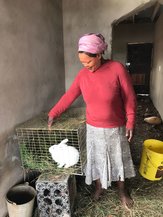
Rabbits could be the answer to the food security needs of Africa’s rural and suburban areas where a large sector of unemployed and underfed people live. Struggling communities can be taught sustainable food production based on rain harvesting, growing vegetables and having pens of rabbits to supply the protein required for good health.
Many rural communities have a prominence of elderly people and children. Cattle, goats and sheep are not easy for them to manage while chickens are impractical as they need grains, which can be used for human food.
Advantages of rabbit farming are manyfold: rabbits have the highest protein quantity of all farmed meats and therefore a small amount of meat goes far in supplying nourishment. They require far less space than any other meat-producing animal and are easy to handle. They can be fed from the vegetable garden and eat leftovers like old bread and leftover mielie meal pap.
However, it is essential that communities receive mentoring. Rabbits should be kept in cages, therefore, dependant on management and if neglected, could die a slow and terrible death.
To start, you would need water, a vegetable garden and management. Rainwater should be collected using simple guttering guiding water into drums or water tanks. Harvested rainwater is then used for irrigation of a vegetable garden that must be productive throughout the year. Plant vegetables and certain herbs to be in constant supply.
Carrots and spinach are excellent feed - the tops and stalks go to the rabbits, but also cauliflower, some cabbage and beetroot can be fed. Parsley is an excellent feed and tonic while wild strawberries is an essential medication and stinging nettles make excellent hay. Hay can be cut from young wild grasses and is vital for this kind of feeding system.
Manure from the rabbits goes straight back into a compost heap or even directly onto the vegetables as an excellent fertiliser. The offspring of rabbits farmed in this way can be used to feed the family, bartered for other products or sold as breeding stock to new potential farmers - who are, in turn, correctly mentored.
The pelts from slaughtered rabbits can either be hand-tanned or collected and tanned at tanneries. This depends on the quality of the fur. Only high quality rabbit pelts should be commercially tanned as it can be expensive. Many traditional outfits require strips of fur, so rabbit pelts of the right colour such as New Zealand Reds could well be used for headdresses etc.
Furs can be made into slippers, karosses or hats and tails and front feet can be made into keyrings to be sold to the tourist trade. Apart from providing meat, the working of the rabbit skins can create jobs and additional income for the family.
By Karoline Steenekamp